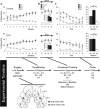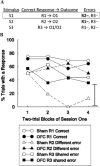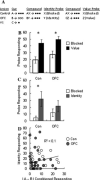Does the orbitofrontal cortex signal value?
- PMID: 22145878
- PMCID: PMC3530400
- DOI: 10.1111/j.1749-6632.2011.06210.x
Does the orbitofrontal cortex signal value?
Abstract
The orbitofrontal cortex (OFC) has long been implicated in associative learning. Early work by Mishkin and Rolls showed that the OFC was critical for rapid changes in learned behavior, a role that was reflected in the encoding of associative information by orbitofrontal neurons. Over the years, new data-particularly neurophysiological data-have increasingly emphasized the OFC in signaling actual value. These signals have been reported to vary according to internal preferences and judgments and to even be completely independent of the sensory qualities of predictive cues, the actual rewards, and the responses required to obtain them. At the same time, increasingly sophisticated behavioral studies have shown that the OFC is often unnecessary for simple value-based behavior and instead seems critical when information about specific outcomes must be used to guide behavior and learning. Here, we review these data and suggest a theory that potentially reconciles these two ideas, value versus specific outcomes, and bodies of work on the OFC.
© 2011 New York Academy of Sciences.
Figures





Similar articles
-
Representations of appetitive and aversive information in the primate orbitofrontal cortex.Ann N Y Acad Sci. 2011 Dec;1239:59-70. doi: 10.1111/j.1749-6632.2011.06255.x. Ann N Y Acad Sci. 2011. PMID: 22145876 Free PMC article.
-
The value of identity: olfactory notes on orbitofrontal cortex function.Ann N Y Acad Sci. 2011 Dec;1239:138-48. doi: 10.1111/j.1749-6632.2011.06268.x. Ann N Y Acad Sci. 2011. PMID: 22145883 Review.
-
Balkanizing the primate orbitofrontal cortex: distinct subregions for comparing and contrasting values.Ann N Y Acad Sci. 2011 Dec;1239:1-13. doi: 10.1111/j.1749-6632.2011.06267.x. Ann N Y Acad Sci. 2011. PMID: 22145870 Free PMC article. Review.
-
The orbitofrontal cortex and response selection.Ann N Y Acad Sci. 2011 Dec;1239:25-32. doi: 10.1111/j.1749-6632.2011.06279.x. Ann N Y Acad Sci. 2011. PMID: 22145872 Free PMC article. Review.
-
The orbitofrontal cortex and the computation of subjective value: consolidated concepts and new perspectives.Ann N Y Acad Sci. 2011 Dec;1239:130-7. doi: 10.1111/j.1749-6632.2011.06262.x. Ann N Y Acad Sci. 2011. PMID: 22145882 Free PMC article. Review.
Cited by
-
Reinforcement learning models and their neural correlates: An activation likelihood estimation meta-analysis.Cogn Affect Behav Neurosci. 2015 Jun;15(2):435-59. doi: 10.3758/s13415-015-0338-7. Cogn Affect Behav Neurosci. 2015. PMID: 25665667 Free PMC article. Review.
-
Imbalanced Activity in the Orbitofrontal Cortex and Nucleus Accumbens Impairs Behavioral Inhibition.Curr Biol. 2016 Oct 24;26(20):2834-2839. doi: 10.1016/j.cub.2016.08.034. Epub 2016 Sep 29. Curr Biol. 2016. PMID: 27693139 Free PMC article.
-
Foundations of human spatial problem solving.Sci Rep. 2023 Jan 27;13(1):1485. doi: 10.1038/s41598-023-28834-3. Sci Rep. 2023. PMID: 36707649 Free PMC article.
-
A Literature Review on the Efficacy and Related Neural Effects of Pharmacological and Psychosocial Treatments in Individuals With Internet Gaming Disorder.Psychiatry Investig. 2021 Dec;18(12):1149-1163. doi: 10.30773/pi.2021.0207. Epub 2021 Dec 8. Psychiatry Investig. 2021. PMID: 34872237 Free PMC article.
-
Transfer of learning relates to intrinsic connectivity between hippocampus, ventromedial prefrontal cortex, and large-scale networks.J Neurosci. 2014 Aug 20;34(34):11297-303. doi: 10.1523/JNEUROSCI.0185-14.2014. J Neurosci. 2014. PMID: 25143610 Free PMC article.
References
-
- Jones B, Mishkin M. Limbic lesions and the problem of stimulus-reinforcement associations. Exp. Neurol. 1972;36:362–377. - PubMed
-
- Butter CM. Perseveration and extinction in discrimination reversal tasks following selective frontal ablations in Macaca mulatta. Physiol. Behav. 1969;4:163–171.
-
- Meunier M, Bachevalier J, Mishkin M. Effects of orbital frontal and anterior cingulate lesions on object and spatial memory in rhesus monkeys. Neuropsychologia. 1997;35:999–1015. - PubMed
-
- McAlonan K, Brown VJ. Orbital prefrontal cortex mediates reversal learning and not attentional set shifting in the rat. Behav. Brain Res. 2003;146:97–130. - PubMed
Publication types
MeSH terms
Grants and funding
LinkOut - more resources
Full Text Sources

